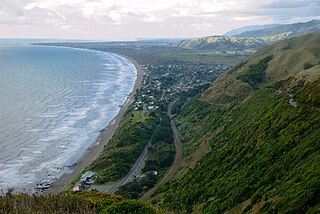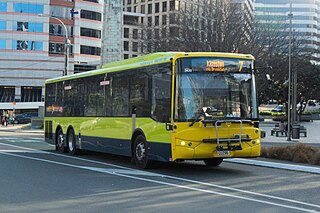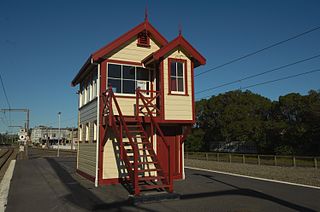
41°17′S174°46′E

The Kāpiti Coast District is a local government district of the Wellington Region in the lower North Island of New Zealand, 50 km north of Wellington City. The district is named after Kapiti Island, a prominent island 5 kilometres (3.1 mi) offshore.

Raumati South is a coastal community on the Kapiti Coast of New Zealand's North Island. It is 50km north-west of Wellington, and immediately south of Raumati Beach and south-west of Paraparaumu. The Maungakotukutuku area is located inland.

Paekākāriki is a town in the Kapiti Coast District in the south-western North Island, New Zealand, and one of the northernmost suburbs of Wellington. It lies 22 km (14 mi) north of Porirua and 45 km (28 mi) northeast of the Wellington CBD. The town's name comes from the Māori language and can mean "parakeet perch". Paekākāriki had a population of 1,665 at the time of the 2013 census, up 66 from the 2006 census.

Paraparaumu is a town in the south-western North Island of New Zealand. It lies on the Kapiti Coast, 55 kilometres (34 mi) north of the nation's capital city, Wellington.

The Wellington Region has a well developed public transport system, the most used in New Zealand. It consists of electric and diesel buses, commuter trains, ferries and a funicular. It also included trams until 1964 and trolleybuses until 2017.

The Kapiti Urban Area is a statistical area that was defined by Statistics New Zealand to cover a group of urban settlements of the Kāpiti Coast District, in the Wellington Region. It was classified as a main urban area under the New Zealand Standard Areas Classification 1992 because its population exceeded 30,000.
Wellington Regional Council, branded as Greater Wellington Regional Council, is the regional council overseeing the Wellington Region of New Zealand's lower North Island. It is responsible for public transport under the brand Metlink, environmental and flood protection, and the region's water supply.

Kapiti Coast Airport, previously called Paraparaumu Airport, is on the Kapiti Coast of New Zealand's North Island, between the Wellington dormitory suburbs of Paraparaumu Beach, Paraparaumu to the east, and Raumati Beach to the south. The Wharemauku Stream flows through part of the airport's land.

Metlink's Kapiti Line is the electrified southern portion of the North Island Main Trunk railway between New Zealand's capital city, Wellington, and Waikanae on the Kapiti Coast, operated by Transdev Wellington on behalf of Greater Wellington Regional Council. Trains run frequently every day, with stops at 16 stations. Until 20 February 2011 it was known as the Paraparaumu Line.

Battle Hill Farm Forest Park is a regional park near Paekākāriki, in the Kāpiti Coast District and Wellington Region of New Zealand's lower North Island.
The Wellington local elections, 2010 are part of the 2010 New Zealand local elections, to elect members to sub-national councils and boards. The Wellington elections cover one regional council, eight territorial authority councils, three district health boards, and various community boards and licensing trusts.

Paekakariki railway station in Paekākāriki on the Kapiti Coast, New Zealand is an intermediate station on the Kapiti Line for Metlink's electric multiple unit commuter trains from Wellington. Paekākāriki was the terminal station of the commuter service from 1940 to 1983, when the service was extended to Paraparaumu, and to Waikanae in 2011.

The Kāpiti Expressway is a four-lane grade-separated expressway on New Zealand's State Highway 1 route through the Kapiti Coast north of Wellington. From the northernmost terminus of the Transmission Gully Motorway at Mackays Crossing just north of Paekākāriki, it extends northwards 31 km (19 mi) to just north of Ōtaki, bypassing the former two-lane route through Raumati South, Paraparaumu, Waikanae, Peka Peka, Te Horo and Ōtaki.
Ngā Uruora - Kāpiti Project is a community conservation project set up in Paekākāriki, New Zealand in 1997 by Fergus Wheeler. It is named after the book Ngā Uruora: The Groves of Life - Ecology & History in a New Zealand Landscape by ecologist Geoff Park. The main aims of Ngā Ururoa are protecting and restoring the Kapiti Coast's unique kohekohe forest, re-establishing forests through planting programmes, and undertaking pest and weed control.

Paekākāriki Hill is a rural locality in Porirua in New Zealand's North Island. It is located inland, behind Paraparaumu and Raumati. Paekākāriki Hill Road runs approximately north to south from Paekākāriki to Pāuatahanui. Grays Road runs along the northern coast of Te Awarua-o-Porirua Harbour's Pauatahunui Arm, which forms the locality's southern boundary.

Mackays Crossing is a locality in the Kapiti Coast District of New Zealand's North Island, located between Paekākāriki to the south and Raumati South to the north.
The 2022 Wellington local elections were held on 8 October 2022 as part of the wider 2022 New Zealand local elections to elect members to sub-national councils and boards. The Wellington elections cover one regional council, eight territorial authorities, and various community boards and licensing trusts.















